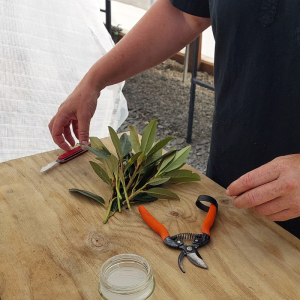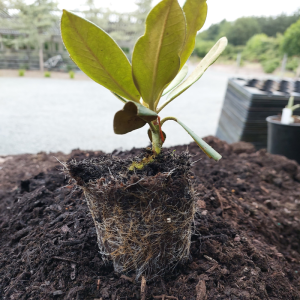🌿 Lisa is Going Potty Potting Up!
If you’ve ever wondered what happens before a rhododendron ends up ready for sale at RhodoDirect, let me take you behind the scenes. There’s never any downtime here in the nursery — it’s a constant cycle of growing, potting, pruning, and re-potting again! And now that we’ve added a wholesale element, it simply means more plants, more potting up… and a lot more fun juggling space!
So, what’s the life cycle of a rhododendron here at RhodoDirect? It’s quite the journey — and every stage has its own magic.
🌱 Step 1: Cuttings and Hope (February–March)

It all begins in late summer, around February and March, when I take thousands of cuttings from selected plants. Each one is carefully prepared and placed into hygiene trays — and then comes the waiting (and finger-crossing) stage!
We rely on timing, technique, and a bit of luck — making sure the cutting material is at just the right stage and the rooting hormone mix is spot on. Preparing all these trays usually takes around four weeks, from the first cutting to the last. Then it’s a waiting game of three to five months, watching closely and hoping to see those first tiny roots begin to form.
🌿 Step 2: Into Jiffy Pots
Once the roots have developed, the baby rhodos graduate into jiffy pots — small, biodegradable pots that allow the new roots to grow straight through the sides into the potting mix.
Some cuttings take off quickly, while others like to take their time — depending on how strong their initial root ball was. Generally, it takes another three to four months before the roots start showing through the jiffy pot. That’s when I know they’re ready for their next move!
🌸 Step 3: Potting into 2 Litres

A jiffy cutting ready for potting.
The next step is potting them into 2-litre pots, where they’ll stay for about a year. During this time, they’re pruned regularly to encourage a strong, bushy shape rather than tall, lanky growth. It might seem counterproductive to trim them back, but this early pruning sets them up to be sturdy, well-proportioned plants later on.
🌳 Step 4: Potting Up Again (6 Litres and Beyond!)
After their year in 2-litre pots, it’s time to move them up to 6-litre pots — their final growing home before sale. They’ll usually stay in these for another year, filling out beautifully until they’re lush, healthy, and ready to go home with gardeners.
By the time a rhododendron is fully grown and sale-ready, it’s been through 4–5 years of care — from a tiny cutting to a thriving plant, often with its very first flower buds forming around year four.
🌼 The Musical Chairs of the Nursery
Of course, not all the plants grow at the same pace — this year especially, it feels like everyone wants to be potted up at once! I’m constantly playing musical chairs with plants across the nursery, finding each one its best growing spot for light, shelter, and air circulation.
It’s a bit of a juggling act, but it’s part of what makes nursery life so rewarding. Watching these plants progress through each stage — and finally see them bloom — never gets old.
💚 Four to Five Years of Patience and Passion
When you pick up a rhododendron from RhodoDirect, you’re not just buying a plant — you’re taking home something that’s been four to five years in the making. Each one has been hand-propagated, nurtured, and shaped with care from the very beginning.
So yes — I really am going potty potting up! But when you love what you do, it’s the best kind of busy there is. 🌸
Beyond their function, these markings have become a hallmark of certain rhododendron varieties, sought after by gardeners who appreciate their unique patterns. Whether you’re drawn to the bold contrasts or the subtler hints of colour, these “eyes” make each rhododendron feel like its own natural masterpiece.
